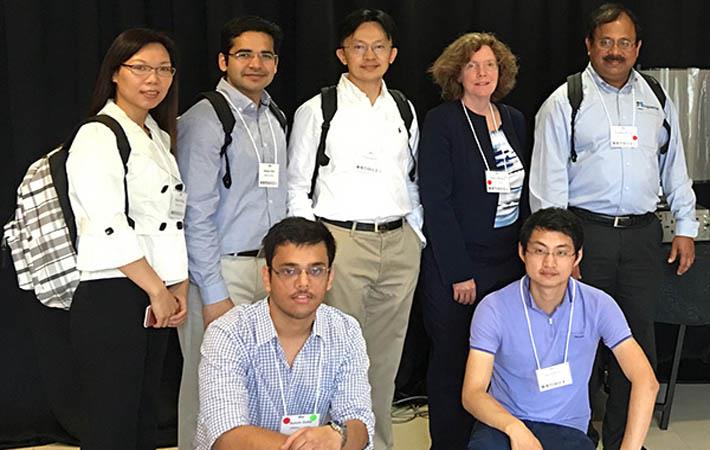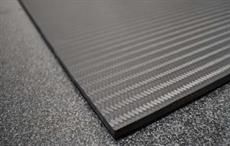UMass Lowell scientists are collaborating with a research and development company to create new, cost-effective sensor-laden textiles - fabrics integrated with optical fibres and sensors - to monitor the structural health and integrity of vital infrastructures such as buildings and skyscrapers, roadways, bridges, tunnels, railway tracks, dams and pipelines.
UMass Lowell team leader Associate Professor Tzuyang Yu and Prof Pradeep Kurup of the Department of Civil and Environmental Engineering, along with Prof Xingwei Wang of the Department of Electrical and Computer Engineering, are collaborating with researchers from Saint-Gobain, a multinational corporation with a research and centre based in Northborough to develop fabrics integrated with optical fibres and sensors. These “sensing fabrics” can be applied to existing structures to monitor strain or detect cracks in their early stages, minimising maintenance costs, environmental impacts and disruptions to the people’s lives and businesses.UMass Lowell scientists are collaborating with a research and development company to create new, cost-effective sensor-laden textiles - fabrics integrated with optical fibres and sensors - to monitor the structural health and integrity of vital infrastructures such as buildings and skyscrapers, roadways, bridges, tunnels, railway tracks, dams and pipelines.#
In 2016, the American Society of Civil Engineers gave America’s infrastructures an overall grade of D+, indicating they urgently need major repairs and improvements to make them safe, sustainable and economically efficient. The new textiles aim to contribute toward that effort.
“Optical fibre sensors are very suitable for structural health monitoring due to their lightweight, low-cost, survivability in harsh environments and immunity to electromagnetic environments,” said Wang, a Shrewsbury resident. “More importantly, they can provide fully distributed sensing information about an object’s structural integrity. Combined with novel textile technology, the sensing fabrics will be relatively easy to install and maintain. They will be very useful for long-distance sensing applications.”
The project is supported by $853,000 grant from the Advanced Functional Fabrics of America (AFFOA), which is part of the National Network of Manufacturing Innovation Institutes. AFFOA’s mission is to enable the manufacturing industry to transform traditional fibres, yarns and textiles into highly functional integrated and networked devices and systems. In addition, the Commonwealth of Massachusetts awarded the researchers a $550,000 grant through the Massachusetts Manufacturing Innovation Initiative.
The ASCE estimates that a $2 trillion investment over the next decade is needed for the necessary repairs and upgrades of the country’s infrastructure.
“The unique sensing capability of our proposed fabric will enable engineers to better predict the structural health of civil infrastructures and assist decision makers and stakeholders to better distribute limited resources for infrastructure repair, rehabilitation or rebuild,” said Yu.
Corrosion, one of the issues causing deterioration of infrastructure, does $13.6 billion damage to highway bridges annually, according to the National Association of Corrosion Engineers.
“The use of our proposed sensing textiles can help proactively assess the structural integrity of concrete and steel bridges,” Yu said.
“Our proposed sensing textile product can be used on concrete ties and steel rails as well as under ballasts to monitor the structural health of railroad tracks. A distributed sensing system for railroads will enable engineers to mitigate local damages through effective repair and strengthening, thereby avoiding unnecessary and costly rail replacement,” he said.
There are more than 470 tunnels around the US and millions of miles of oil, gas and water pipes, according to Kurup, who said maintenance of all of these represents significant challenges for those responsible. For example, he said, the American Water Works Association estimates $1 trillion will be needed over the next two decades to implement much-needed repairs and upgrades.
The team’s sensing textile will allow engineers to detect damages early on, thereby preventing catastrophic failures, Kurup says.
Yu says that the development of the sensing fabrics will also create new business with the manufacturing, installation and maintenance of the fabrics as well as the processing and analysis of the sensor data.
“This research project combines two traditional industries – textiles and construction – to create innovative sensor and sensing system products for the aging infrastructure problem faced by all countries in the world,” said Yu. “We envision that this Massachusetts-based research and development effort will expand the local economy by creating new products to address a critical need nationwide, as well as strengthen the technical edge of the US in today’s globally competitive market.” (SV)
Fibre2Fashion News Desk – India


